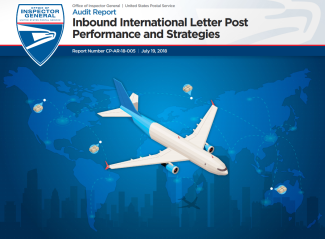Inbound International Letter Post Performance and Strategies
Objective
The Universal Postal Union (UPU) is a United Nations agency that facilitates the exchange of international postal services. The UPU sets the rules for international mail exchange and makes recommendations to stimulate growth in mail and improve the quality of service for customers. The U.S. is a member of the UPU and exchanges mail in accordance with UPU standards. In 2005, the UPU developed a program to increase the volume of letter post mail and improve service performance.
The program is based on an incentive where countries receive a participation bonus in addition to their terminal dues. Terminal dues are payments received from originating countries for the delivery of their mail. The participation bonus is 5 percent of the total terminal dues for the calendar year. Countries forfeit a portion or all of the bonus as well as up to a 5 percent reduction in terminal dues if standards are not met. Reductions are based on the level of service performance below UPU standards.
Our objective was to assess the service performance of inbound international letter post mail and strategies to meet service performance standards.
What the OIG Found
The U.S. Postal Service met International Letter Post service performance standards only once since the inception of the UPU program in 2005. In calendar year (CY) 2017, the Postal Service missed the UPU service performance target by about [redacted] percent.
Although the Postal Service does not have strategies specific to inbound international letter post mail, it has strategies to improve the overall service performance of First-Class mail, which includes inbound international letter post mail. The UPU-accepted service standards align to the domestic service standards of the country of destination; therefore, the Postal Service does not distinguish between domestic and international mail. However, some domestic mail service standards differ from UPU-accepted service standards. For example, some domestic mail service standards follow a three- to five- day delivery cycle, which is different from the two- to three-day standard used by the UPU. The PRC has instructed the Postal Service to develop strategies to meet UPU service performance metrics because current strategies have not been sufficient to meet UPU service performance targets.
We identified the following issues that impact inbound international letter post service performance standards:
- Mail Quality: Deficiencies in the quality of mail from international postal services makes it difficult for letter post mail to run on automated equipment.
- Stop-the-Clock readings: Due to the volume of mail awaiting inspections by Customs and Border Protection personnel, [redacted].
- Mail Volume: Due to the volume of inbound mail received in sacks at the [redacted] International Service Center, management informed us they have not found an efficient way to process mail and [redacted].
- Facility Layout: Management informed us that, at times, there are delays in processing mail at the [redacted] Processing and Distribution Center because of the layout of the facility. Equipment needed to process international letter post mail is spread throughout the facility, on different floors, which extends the processing time needed for letter post mail.
Further, the Postal Service does not perform detailed analysis of UPU service performance data. Postal Service management stated they conducted quality control reviews of UPU test mail but did not focus on a detailed analysis of service performance standards. For CY 2017, only [redacted] percent of letter post achieved the two- to three-day UPU service performance metric (from the first acceptance scan in the U.S. to the addressee’s mailbox). Reviewing service performance data at a more detailed level, for example, by tracking and analyzing mail processing scans from the International Service Center to the Processing & Distribution Center, could be used to identify where mail processing delays occur related to service performance targets.
As a result of not meeting the service performance standard, the Postal Service forfeited about [redacted] million annually in revenue for CYs [redacted] and [redacted], and will have a projected loss of about $[redacted] million annually over the next four years.
What the OIG Recommended
We recommended management:
- Develop a strategic plan for inbound international letter post mail that is specifically aligned with UPU-accepted service standards and addresses mail processing deficiencies to improve the overall service performance of inbound international letter post mail.
- Evaluate resources to track and analyze UPU processing scans to identify service standard failures that prevent the Postal Service from meeting UPU service performance targets and to support the development of strategies to improve service performance.

